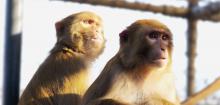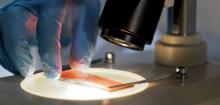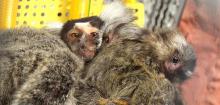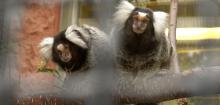Last Friday 29 March, two news shows made by the Netherlands Broadcasting Corporation (NOS) broadcast a news item about animal experiments, the NOS Journaal for adults and the Jeugdjournaal for children. In order to make these items they visited BPRC, prompted by the news that the number of animal experiments will be gradually decreasing in the coming years.
Dutch kids's TV show 'Zapp Buitendienst' visits BPRC
21 Mar 2019 | Back to News, Publications and Annual Reports‘It's like a zoo in here’
This week, Dutch children's TV programme Zapp Buitendienst is zooming in on animal experiments. That's something we at BPRC know all about. Series presenters Nienke and Sosha came to visit and took a look behind the scenes so they could give their viewers the full story. This episode of the popular kid's show aired Friday March 22 on NPO 3 at 5:45 pm.
There was good news two weeks ago for the fight against depression and obsessive-compulsive neuroses. This article (in Dutch) on the online knowledge platform Nationale Zorggids (National Care Guide) describes how scientists have managed to change brain activity in monkeys, 'meaning that ultrasound could possibly be used to treat depression and other brain disorders in the future'.
'We still know very little about dementia'
14 Mar 2019 | Back to News, Publications and Annual ReportsHugo de Jonge, the Dutch Minister of Health, Welfare and Sport, announced last month that he would be making additional funds available for dementia research. He intends to double the budget (€48 million) that has already been set aside until 2020 for addressing dementia. De Jonge is convinced that better treatments need to be developed. 'It is well on its way to becoming the number-one public disease,' he said in this television programme.
How the innate immune system in humans and monkeys is regulated identically
14 Mar 2019 | Back to News, Publications and Annual ReportsResearchers in BPRC's Alternative Methods Unit have discovered a new route for regulating the innate immune system. This is important, because many therapies for serious diseases focus on either activating or inhibiting the immune system.
Marmosets and their offspring: twins are better than triplets
01 Mar 2019 | Back to News, Publications and Annual ReportsDid you know that marmosets often have twins? And triplets? And sometimes even quadruplets?!
This species is known for its striking white ear tufts. These little primates weigh around 350 grams on average and live in stable extended families. (In this report, we describe how they live together.) Usually there is one monogamous breeding pair, which often has twins or triplets.
Report on the new marmoset enclosures
‘Hi girl, do you want to take a look? How nice.’ Animal care worker Marit is standing in front of a renewed outdoor enclosure for the smallest primates at the BPRC site: the common marmosets, known for their striking white ear tufts. ‘We usually call them marmo’s.’
BPRC to receive additional funds for malaria research. The Netherlands Organisation for Health Research and Development (ZonMW) is granting us this aptly-named TOP grant. ZonMW considers this instrument to be the key driver for innovation in the long term.
'This is Donald, he recently had an amazing holiday in the tropics. But shortly after he got back he felt ill and had to go to the hospital.' This is how the animated film begins, with a cheerful tune, made by PhD candidates from the Marie Curie HONOURs project and largely funded by the EU.
Ray of hope in treatment of Parkinson’s symptoms
05 Feb 2019 | Back to News, Publications and Annual ReportsAlthough there is currently no cure for Parkinson’s disease, it is possible to manage many of the symptoms. In this light, BPRC researchers have made an interesting discovery during a study on primates. Their research offers new possibilities for therapies that may improve the quality of life of Parkinson’s patients.
Parkinson’s disease is a condition that affects the brain. It causes certain brain cells to die off, which in turn leads to reduced production of dopamine. This substance is crucial to proper body movement and motor output control.











